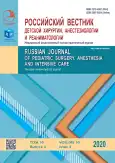Inhalation anesthesia in children in outpatient dentistry: xenon or sevoflurane?
- Authors: Lazarev V.V.1, Khaliullin D.M.2
-
Affiliations:
- N.I. Pirogov Russian National Research Medical University
- LC “Dental Forte Elit”
- Issue: Vol 10, No 4 (2020)
- Pages: 435-443
- Section: Original Study Articles
- URL: https://journals.rcsi.science/2219-4061/article/view/122941
- DOI: https://doi.org/10.17816/psaic721
- ID: 122941
Cite item
Full Text
Abstract
Abstract. The choice of optimal anesthetic in outpatient dental practice is an important stage in treatment plan preparation for children who need oral sanitation under general anesthesia. Few works were devoted to the comparative characterization of sevoflurane and xenon, especially in conditions of outpatient dental practice.
Aim. This study aimed to compare the characteristics of xenon and sevoflurane inhalation anesthesia at the stage of maintaining anesthesia in outpatient dental practice.
Materials and methods. This is an open, comparative, and randomized study, in parallel groups with random sampling. A total of 103 patients of both sexes aged 2–12 years were included. Children were divided into 2 groups: group 1 (35 children), with sevoflurane anesthesia and group 2 (68 children), with xenon anesthesia. In each and between groups at stages of anesthesia, data from the bispectral (BIS) index, heart rate, blood pressure, lung ventilation, glucose, acid-base status, and ionic composition of venous blood were monitored.
Results. Significant differences between groups were observed in the BIS-index values at the end of anesthesia, indicating a faster awakening of patients under xenon anesthesia. Blood pressure and heart rate indicators in the xenon group at the beginning and end of the study are not statistically significant compared to the sevoflurane group. Remaining indicators did not show significant differences between groups.
Conclusion. The use of sevoflurane and xenon during general anesthesia in outpatient dental practice characterized by the stability of the acid-base state, ion composition, and glucose concentration allows adequate conditions for spontaneous ventilation with pressure support. However, a faster awakening of the patient at the end was observed when using xenon. Diastolic blood pressure and heart rate in the xenon group after the end of anesthesia are close to baseline values.
Keywords
Full Text
##article.viewOnOriginalSite##About the authors
Vladimir V. Lazarev
N.I. Pirogov Russian National Research Medical University
Email: lazarev_vv@inbox.ru
ORCID iD: 0000-0001-8417-3555
Dr. Sci. (Med.), Professor, Head of Department of pediatric anesthesiology and intensive therapy
Russian Federation, MoscowDinar M. Khaliullin
LC “Dental Forte Elit”
Author for correspondence.
Email: dr170489@yandex.ru
ORCID iD: 0000-0003-2771-3134
anesthesiologist resuscitator
Russian Federation, Naberezhnye ChelnySupplementary files






